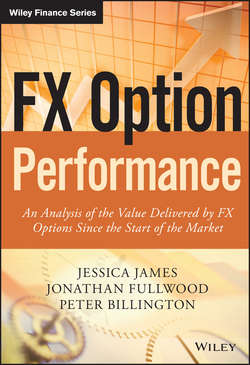Читать книгу FX Option Performance - Peter Billington - Страница 10
На сайте Литреса книга снята с продажи.
CHAPTER 1
Introduction
1.5 HISTORY AND SIZE OF THE FX OPTION MARKET
ОглавлениеDuring the mid-1980s a confluence of events gave birth to the FX option market as we know it today, namely: a demand for the product, the ability to price the product, a market place to trade and, with the advent of computer power, the ability to manage risk.
To have an option market, first it is necessary to have a liquid market in the underlying rate (usually called just the underlying) upon which the options are based. Before the 1970s, when exchange rates were in general fixed to specific values and adjusted at intervals, there was no possibility of an option in the market. But as different countries gradually abandoned the increasingly unworkable fixed FX rate regime which had been implemented after the post-war Bretton–Woods agreement, risk appeared, and the first to take note and act upon this risk were the corporations of the world. As has been described earlier, companies with income and liabilities in other countries are highly sensitive to exchange rate fluctuations and seek ways to minimise them. Corporate treasurers initially used forward FX contracts to lock in rates but then realised they could sell them if the contracts entered very negative territory, assuming a trending market, and replace them if they became close to positive once more. This crudely replicates the protective properties of an option, though it was a cumbersome and imprecise process. The idea of a product where another company took over this adjustment process was attractive. The very early currency overlay companies did exactly this, calling it option replication. As the markets started to swing wildly during the 1980s the demand for this increased. True options in FX began to be bought and sold, though the correct price for an option was hotly debated.
Equity option traders began to use the Black-Scholes-Merton model shortly after its publication in 1973 [1] but there was at that time little thought of using it for FX contracts. In 1983 Garman and Kohlhagen published the extension to the Black-Scholes-Merton model which enabled FX options to be clearly and simply valued for the first time, as it included dual interest rates [4].
With the demand for the product, and the ability to price it, came the distribution. The first FX option was dealt on the Philadelphia Stock Exchange in November 1982 [5]. At that time they were a small futures exchange who courageously introduced the new instrument when there was no OTC12 market at all, and virtually no other instruments available to use as pricing references. These options, consistent with similar equity products at the time, were, American-style, exercisable by the option purchaser any time up to expiry, which would have made them even more challenging to value. But clearly they showed promise; by the mid-1980s the exchange in Chicago was also actively trading contracts on FX options, and the number of boutique option houses grew.
Конец ознакомительного фрагмента. Купить книгу
12
OTC means Over The Counter, a reference to a liquid secondary market where many market users are willing to trade with each other off-exchange. Because the trades are bilateral, contracts are not limited to standard formats as is the case for exchange-traded products.
